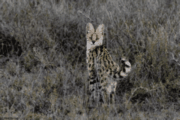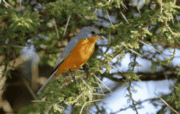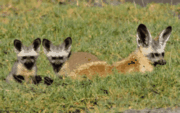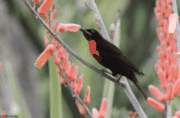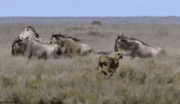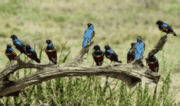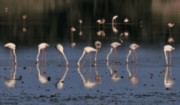Mike Mockler Tanzania December 2012 |
Below is Mike’s account of his recent safari in Tanzania... THE PLAINS BURST INTO LIFE The day before we arrived in the Serengeti, the plains were parched, dusty and relatively empty; lakes and water-courses were bone-dry. However, not for the first time, our arrival coincided with a wonderful, life-giving downpour. The transformation was sensational. Overnight, streams began to flow, lakes filled and, as if by magic, flamingos and other water-birds appeared from nowhere to feed in the shallows. The grasslands began to reveal a luminous green flush and were suddenly sprinkled with white and pink flowers. Within hours, the first lines of wildebeest appeared over the horizon, trekking towards the short-grass plains where they like to spend the rainy season. Migrant birds poured in with the wildebeest - white storks, swallows, swifts, bee-eaters, rollers, lesser kestrels, eagles and harriers. Within a day or two, the plains were filled with tens of thousands of wildebeest, zebras and gazelles; there were animals as far as the eye could see in all directions. I have seen this incredible phenomenon many times yet it still takes my breath away. Suddenly, the wildlife-viewing was much more intense. Hyenas moved into the area in big numbers and we were treated to some dramatic interaction between them and the local lions, suddenly spoilt for choice with a newly-abundant food supply. Two handsome pride males are father and son, an unusual arrangement as pride males usually drive adolescent males away before they can threaten their dominance. They are a magnificent pair and somehow manage to defend two, perhaps three, different prides. In late October, the son, known as Young Tom, was found close to death with dreadful wounds caused by Masai spears and clubs. Happily, after veterinary care, he made a remarkable recovery and was a picture of health when we last saw him. There were also herds of buffalo eyeing us suspiciously as we drove past. As usual, they attracted flocks of oxpeckers which provide a free grooming service, picking annoying ticks and flies from various orifices, including ears and nostrils. At night, some of the buffalos came into the lodge grounds to graze, a common phenomenon around lodges: it seems they feel safer from lions close to human activity. For our part, we were wary of the buffalos as we walked to and from our room in the dark. There were breeding herds of elephants in the acacia woodland, scores of giraffes and more bat-eared foxes than I had seen there in over 20 years. Bat-eared foxes are such charming animals and every den contained delightful youngsters that peeped out, wide-eyed and prick-eared, as we approached before scuttling back down below ground. Add to all this good sightings of leopard, aardwolf and a gorgeous serval and you have the makings of a very special safari! Bird-watching was superb. Secretary birds stalked the grassland and courted flamboyantly on the tops of low trees where they would soon build their nests. Kori bustards strutted their stuff to impress potential mates out on the plains and, wherever one looked, birds of prey of many different species soared, swooped and perched: bateleurs, black-chested snake-eagles, gabar goshawks, black-shouldered kites, pygmy falcons. Among the many migrant steppe eagles, there was a "mystery eagle" which I thought was probably a large steppe eagle but showed some plumage features reminiscent of eastern imperial eagle, a very rare migrant in Tanzania. Subsequent discussions with experts (including a world authority on eagles) led to the conclusion that it was indeed a steppe eagle with some aberrant plumage, especially around the crown and nape. As water-holes filled up, black-winged stilts, yellow-throated and chestnut-bellied sandgrouse and the elusive greater painted-snipe appeared while the woodlands contained many smaller birds like silverbird (a very attractive flycatcher), lesser grey and red-backed shrike and several species of cuckoo. In the lodge grounds, grey woodpeckers and Fischer's lovebirds squabbled over potential nest-holes in tree trunks, superb starlings and various weavers swarmed around the birdbath while scarlet-chested sunbirds and variable sunbirds probed flowers for nectar. Cheetahs were at the centre of the most memorable highlights. In fact, there were so many cheetah mothers with cubs it was not easy to know which family was which. However, subject to confirmation of IDs by the Serengeti cheetah research team, it seems that we saw at least 25 different cheetahs (and possibly as many as 30) to add to the ten we had seen earlier in Kenya. They provided endless entertainment, especially the playful cubs, several of which indulged in tree-climbing, not a skill that cheetahs ever really master. Although for the cubs it was merely a game, for one adult female climbing trees served a more important purpose: it enabled her to see much further in search of prey. Another female, resting with her cubs in long grass, found herself surrounded by a large herd of grazing wildebeest and zebra. Only when the wildebeest and zebra nearly stepped on the cheetah family did they realise the cheetahs were there! The spotted cats suddenly sprang to their feet to avoid being trampled underfoot - which spread complete panic among the prey animals. The mother cheetah and some of the cubs instinctively chased the fleeing wildebeest but without success. Elsewhere, two large male cheetahs pulled down a lone wildebeest. They first spotted their prey on the far horizon at an incredible distance. Even with binoculars it was difficult for us to make it out. Their eyesight is extraordinary. The cheetahs tracked the wildebeest across a vast plain before launching their attack. A lengthy battle ensued during which the wildebeest nearly impaled one of the cheetahs with its horns and hurled the other cheetah off its back. Finally, after dispatching their prey, the already exhausted cheetahs dragged the carcase two hundred yards to a tree, where they could feed in the shade. I'm often asked why, after more than 110 safaris, I return to Africa again and again. Surely, people say, you must have seen everything. In fact, nothing could be further from the truth: every safari is different and Africa still surprises and thrills me as much as it did on my very first visit more than three decades ago.
|
|

